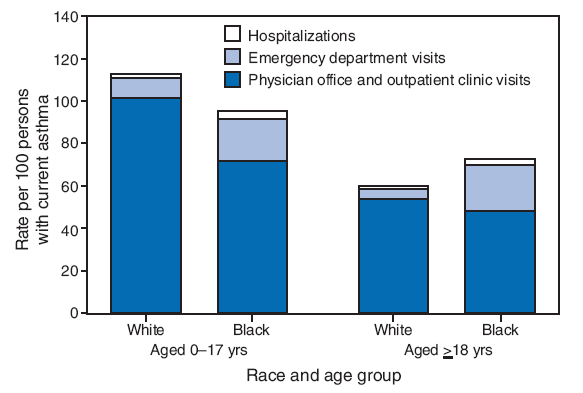Persons using assistive technology might not be able to fully access information in this file. For assistance, please send e-mail to: mmwrq@cdc.gov. Type 508 Accommodation and the title of the report in the subject line of e-mail.
QuickStats: Average Annual Rate of Health-Care Visits for Asthma Among Persons with Current Asthma,* by Type of Visit, Black/White Race, and Age Group --- United States, 2004--2006

* Current asthma were determined by positive responses to the following two questions: "Has a doctor or other health professional ever told you that you have asthma?" and "Do you still have asthma?" Current asthma estimates are from the National Health Interview Survey, 2004--2006, and are based on household interviews of a sample of the civilian, noninstitutionalized U.S. population. Health-care visits for asthma were based on first listing of International Classification of Diseases, Ninth Revision, Clinical Modification (ICD-9-CM) diagnosis code 493.
During 2004--2006, the average annual rate of health-care visits among persons with current asthma was lower for blacks aged <17 years (95 per 100 persons) than for whites (113 per 100). However, among adults with current asthma, the rate of health-care visits was higher among blacks (73 per 100) than among whites (60 per 100). For both age groups, rates for physician office and outpatient clinic visits were higher among whites, whereas rates for emergency department visits and hospitalizations were higher among blacks.
SOURCES: National Ambulatory Medical Care Survey (physician office visits), National Hospital Ambulatory Medical Care Survey (emergency department and outpatient clinic visits), National Hospital Discharge Survey (hospitalizations), annual data files, 2004--2006. National Health Interview Survey (persons with current asthma), annual data files, 2004--2006. Available at http://www.cdc.gov/nchs.
Alternative Text: The figure above shows the average annual rate of health-care visits for asthma among black persons and white persons with current asthma. The rates are further broken down by age group. White children with asthma have more visits than black children, but black adults with asthma have more visits than white adults.


